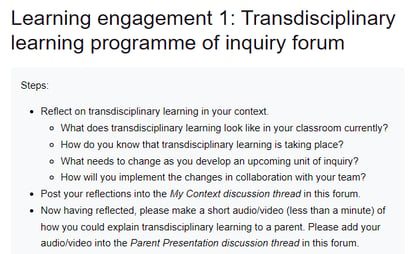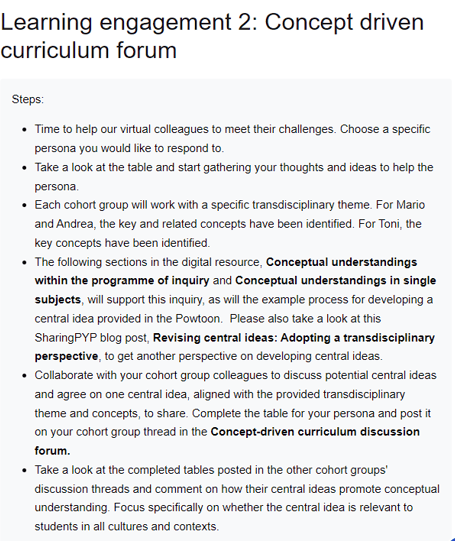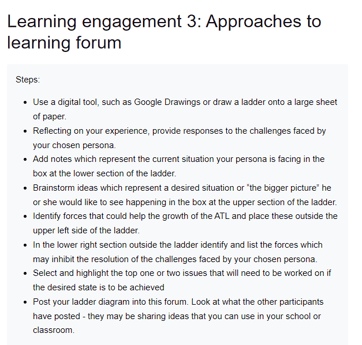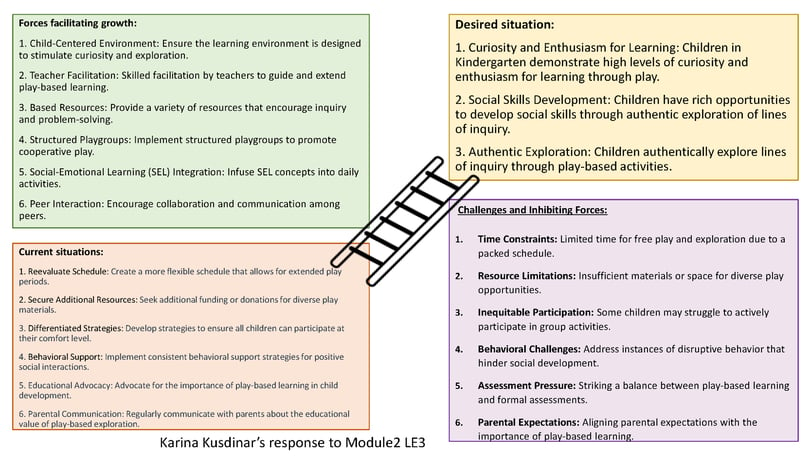Karina at Making PYP Happens Module2
Module 2: Transdisciplinarity and conceptual learning
My Context discussion: Learning engagement 1A: Transdisciplinary learning programme of inquiry
Since I am the Visual Arts teacher for nursery, EY1, EY2, EY3, G!, G2, G3, G4 and G5, I attend all collaborative meeting with each homeroom teachers and other specialist teachers in the beginning/end or whenever they move on to the new unit. We always do our best to collaborate together in creating and assessing projects based on the trasnciplinary theme.
Transdisciplinary learning in my visual arts class looks like:
Themed-based projects: If the current theme across the curriculum is "Sharing the Planet" or "How We Express Ourselves," a Visual Arts project might involve students creating artworks that explore environmental issues or express cultural diversity.
Integration with Other Subjects: Collaborative projects with the Science or Social Studies classes, where students create art that represents scientific concepts or historical events. This could involve researching, interpreting, and visually communicating information.
Inquiry-Based Learning: Instead of isolated art projects, students might engage in inquiry-based learning experiences where they investigate real-world problems or explore questions, integrating aspects of research and critical thinking into their artistic process.
Global Perspectives: Incorporating global perspectives in art projects by exploring the cultural significance of various art forms, studying artists from different parts of the world, or addressing global issues through visual representation.
Reflection and Connection: Encouraging students to reflect not only on the technical aspects of their art but also on the conceptual and thematic connections to other areas of their learning.
I don’t have much of experience yet but I did try to implement changes in collaboration with several indicators of transdisciplinary learning such as:
Connections: Students are able to articulate how their visual arts projects connect with concepts and knowledge from other subjects. They recognize the interdisciplinary nature of their learning.
Inquiry and Exploration: Students demonstrate curiosity and inquiry in their artistic process. They ask questions, seek information, and integrate new knowledge into their creations.
Application of Knowledge: Students apply concepts learned in other subjects to their visual arts projects. For example, if they are studying ecosystems in Science, they might create an art piece that represents the biodiversity of a specific environment.
Reflection on Learning: Reflection is integrated into the learning process. Students regularly reflect on the connections between their art projects and other areas of study, demonstrating a metacognitive awareness of their learning journey.
Collaborative Learning: Students engage in collaborative projects that involve teamwork, communication, and the sharing of expertise from different subject areas. The teacher observes and facilitates these collaborative efforts.
Integration of Global Perspectives Indicator: The inclusion of global perspectives is evident in the choice of themes, artists studied, or cultural elements incorporated into the artworks. Students demonstrate an understanding of how art can be a universal language.
Assessment Criteria: Assessment criteria include not only the technical aspects of art but also the extent to which students demonstrate transdisciplinary skills such as research, critical thinking, and the application of knowledge from different subjects.


Parent Presentation discussion thread: Learning engagement 1B
This is the script for a minute audio recording:
Good day parents, this is Ms. Karina speaking. Imagine your child not just creating art for the sake of it, but delving into projects that tie into their entire learning journey. Our students explore themes like 'How We Express Ourselves' or 'Sharing the Planet,' connecting their artistic expression with what they're studying in other subjects. And it's not just about colors and shapes; it's about exploring the world. We bring global perspectives into our art projects, encouraging your child to appreciate different cultures, traditions, and ways of thinking. Transdisciplinary learning is about more than just creating; it's about understanding, collaborating, and connecting. It's preparing your child not just for the next grade but for a lifetime of learning, curiosity, and global awareness. So, as you step into our world of transdisciplinary learning, know that your child is not just an artist but a thinker, an explorer, and a global citizen in the making. Welcome to the journey of education that goes beyond boundaries
Learning engagement 2: Concept driven curriculum forum (Andrea's persona)
Central Idea:
Exploring Ourselves and Our Community: Developing a Sense of Responsibility and Perspective
Explanation:
This central idea focuses on nurturing young learners' understanding of themselves, their relationships, and their roles in the community. It invites exploration into various aspects of personal, social, and cultural identity, emphasizing the development of responsibility and the ability to view the world from different perspectives.
Lines of Inquiry:
1. Personal Identity:
Exploring personal characteristics, interests, and feelings.
Understanding and appreciating diversity in the classroom.
2. Relationships and Communities:
Investigating family structures, roles, and relationships.
Exploring the concept of communities and the roles people play within them.
3. Rights and Responsibilities:
Understanding basic rights and responsibilities in the classroom and community.
Reflecting on the impact of individual actions on others.
4. Values and Beliefs:
Recognizing and expressing personal values and beliefs. Understanding that people may have different values and beliefs.
5. Initiatives for Personal and Community Well-being:
Exploring activities that contribute to personal well-being (physical, mental, social). Discussing and participating in initiatives that promote community well-being.
Possible Learning Engagements:
1. Family and Friends Collage:
Students create a visual representation of their families and friends, celebrating the diversity within the classroom.
2. Classroom Responsibilities:
Establishing and discussing classroom responsibilities, emphasizing the importance of contributing to a positive learning environment.
3. Community Walk or Virtual Tour:
Exploring the local community, either physically or virtually, to understand the different roles people play and the services they provide.
4.Celebrating Cultural Diversity:
Learning about and celebrating various cultural festivals and traditions within the class.
5. Storytelling and Values:
Sharing and discussing stories that highlight values and morals, encouraging students to express their own values.
6.Community Helper Visit:
Inviting community helpers (police officers, firefighters, etc.) to discuss their roles and responsibilities within the community.
7. Planting Seeds of Responsibility:
Engaging in a gardening activity, emphasizing the responsibility of taking care of living things.
8. Classroom Initiatives:
Collaboratively deciding on and implementing small initiatives to improve the classroom or contribute positively to the school community.
This is what I can think of.
Regards,
Karina


Learning engagement 3: Approaches to learning forum




Karina's reflection of Module 2
Reflection on PYP Principles and Practices:
Participating in the workshop has notably advanced my understanding of PYP principles and practices, particularly in the realm of transdisciplinary learning. Initially familiar with the concept, the workshop deepened my comprehension, highlighting the interconnectedness of subjects and the role of inquiry in fostering holistic understanding. The practical activities, such as sharing an audio/video explanation of transdisciplinary learning, enhanced my ability to articulate these principles. This experience has been pivotal in shaping my approach to teaching, reinforcing the significance of weaving transdisciplinary elements into my curriculum.
Application of Workshop Learning:
The workshop's impact is evident in the practical steps I've taken to apply the learning in my teaching. Sharing the central idea with parents through an audio/video explanation demonstrated a commitment to transparent communication, aligning with the PYP emphasis on collaboration between educators and parents. Posting the ladder diagram template in the Approaches to Learning discussion forum showcases a commitment to collaborative learning, as I share resources that can benefit colleagues. These actions reflect a conscious effort to integrate workshop insights into my teaching practices, fostering a more enriched and collaborative learning environment.
Supporting Agency through the Workshop:
The workshop has been instrumental in supporting and nurturing student agency. The emphasis on transdisciplinary learning encourages students to explore topics that align with their interests and passions, fostering a sense of ownership over their education. By involving parents in understanding the central idea, there is an intentional effort to include stakeholders in the learning process, amplifying student agency. This workshop has contributed to a paradigm shift in my teaching approach, emphasizing student choice, voice, and responsibility in their learning journey.
Reflection on Module 2 Questions:
Learning about Transdisciplinary Elements in PYP:
Module 2 deepened my understanding of key elements within the PYP framework that promote transdisciplinary learning. The significance of concepts as overarching ideas that connect various subjects became clearer. I learned how to craft central ideas that transcend disciplinary boundaries, promoting a more holistic approach to education. This insight is invaluable in fostering a learning environment that goes beyond subject silos, aligning with the core principles of the PYP framework.
Application of Transdisciplinarity in School:
In applying my learning about transdisciplinarity in my school, I've actively participated in curriculum development discussions that emphasize interdisciplinary connections. Collaborating with colleagues, we've worked to design units that encourage students to explore themes and concepts across multiple disciplines. By aligning our teaching strategies with the transdisciplinary approach, we aim to create a cohesive and interconnected learning experience for our students.
Using Concepts to Enhance Student Learning:
Concepts have become a focal point in helping students make meaning and connections in their learning. By incorporating key concepts into lessons, students can see the relevance and interconnectedness of their studies. For example, utilizing the concept of "change" in science, social studies, and literature allows students to explore different aspects of this concept across subjects. This approach enhances their ability to see the bigger picture and understand the applicability of their learning in various contexts.
Contributions of Approaches to Learning to Student Agency:
The approaches to learning have proven instrumental in contributing to student agency. By explicitly teaching and reinforcing skills such as critical thinking, research, communication, socialization, and self-management, students are empowered to take control of their learning. These skills are not only essential for academic success but also contribute to the development of responsible, independent learners. The intentional focus on approaches to learning aligns seamlessly with the PYP goal of nurturing students who are not just knowledgeable but are equipped with the skills needed for lifelong learning and success.


